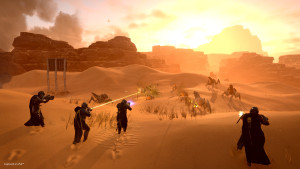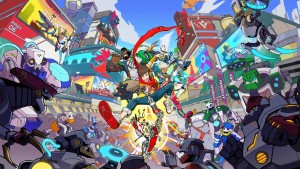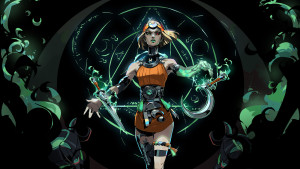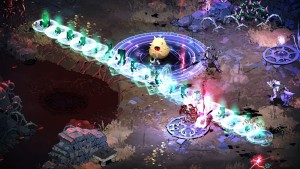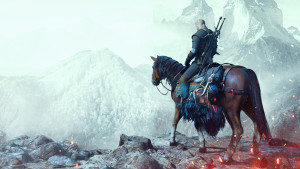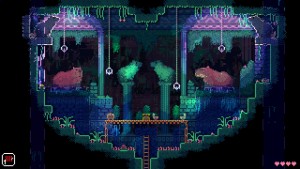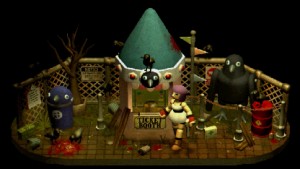Please support Game Informer. Print magazine subscriptions are less than $2 per issue
Reimagining History: Irrational Games
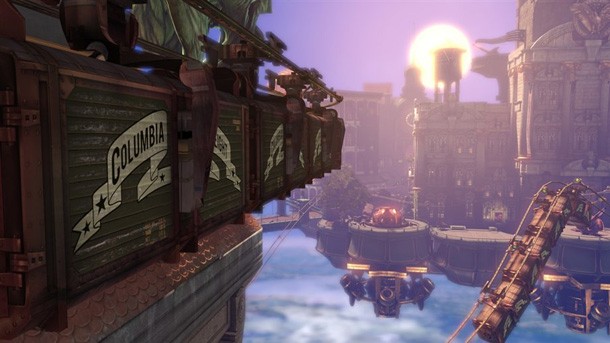
In issue 221 of Game Informer we took a look at the research practices and inspirations of development studios during the creation of era-specific games. Here's the extended interview with Irrational Games' Ken Levine and Nate Wells on developing a 20th century city in the sky.
Game Informer: When it came to BioShock Infinite, did you start with a setting? Or were there gameplay ideas that took priority?
Ken Levine: We started out by researching what BioShock game was to some degree because we knew that we didn’t want to do another game in Rapture. We were very interested in what made a BioShock game and the things that came to us were that it had a setting – not a setting specific setting – but that the setting had to be a character. That was very important. It had to be the biggest character. Rapture is the biggest character in BioShock and Columbia is the biggest character in Infinite. In terms of game systems, how you interact with the world, and how combat plays out, we left that until we tuned into the notion of the period.
Nate Wells: We knew we were going to change the time and the place, and that is a massive emotional and intellectual hurdle to get past – the idea that BioShock could happen outside of Rapture. I guess we jumped it relatively easily, but the truth is that it was difficult to get past. Like Ken said, Rapture is a major character and we were losing a major character. What we were left with was room to make a world that was a bigger and even more significant character than Rapture. But, it also had the liberating effect in that we could do it anywhere and anytime. So then we locked into a period that we found fascinating.
A lot of our interests don’t just crop up when we have to make a new game. They are ongoing and the game inevitably is affected by the zeitgeist of what we are reading and are interested in. We were all reading Devil in the White City and it became interesting to use. Stephen Alexander, the lead effects artist, and I were both reading it at the same time, and we found it very entertaining that if you looked at the layout of the world fair or the Columbian Exposition of 1893, it was very similar to Rapture in that it was a sampling of different parts of the world and different parts of technology. It was arranged sort of like Disney World in that you get a sampling of what they wanted you to see that feels very, very video game. So it was a natural extension of that.
GI: Disney is an exaggerated version of reality.
Wells: We’ll, it’s utopian, and the Columbian Exposition was effectively a utopian endeavor. However temporary, it was a three year project to create a utopia in a swamp in Chicago. And it was absolutely beautiful. And the deeper irony is that it was essentially made out of Paper-maché. You have these beautiful buildings that were this thin layer of plaster over this metal framework. It was all smoke and mirrors. And that is the thing about utopias, right? You can see the connections there to the BioShock franchise.
GI: When you are assembling these pieces is historical accuracy important or is it more important to evoke the feeling of the time?
Wells: We have to cherry pick from history a great deal and what we cherry pick are the things we think can carry a great game design concept, or carry a visual or narrative thread through the game. The idea isn’t that someone shows up at your doorstep and dumps the early 20th century on it, and you have to deal with it. We pick and choose what we want, and there are probably threads of that period of time that aren’t useful to us, so we call them out and narrow our focus on the story we want to tell, and the elements of that theme that will help us tell them.
Levine: Even if you think about it architecturally, a city isn’t built – if you went back to the 1900s – not everything was built in that time period. Some of it is Dutch colonial, from when the Dutch owned New York. And some of that may not say what we want to say. So we aren’t really creating reality, we are sampling from reality. Like with Rapture, it feels like a vision of New York in the fifties and sixties, but New York of the fifties and sixties had some of those buildings, but it also had lots of other buildings.
Wells: New York of the fifties and sixties was built in the twenties and thirties, so architecture reaches incredibly far forward in time. So it is somewhat difficult to decide how to depict this time period.
Levine: You have to be selective. You have a feeling in your head and then you ask how to achieve that feeling. We have this feeling of optimism. Of American optimism. So we asked, "What is going to serve us in doing that?" So before we tuned into the whole American exceptionalism thing, it was much more about Art Nouveau. That is what we were struggling with. We said, "Hey, we did Art Deco before, so I guess we’ll do Art Nouveau now."
Wells: But that was a decorative art, not an architectural art. And it was extremely rare, but it is beautiful. There are so many movies and other design philosophies that used Art Nouveau because it is so interesting.
Levine: But it wasn’t doing anything for us thematically, so we moved on and away from it almost completely. We talked about it and discussed it, and it wasn’t saying anything about our world. I think it was because I didn’t have the themes of the game in hand yet and was leading the horse. It wasn’t saying anything. When we tuned into the American exceptionalism thing that started answering questions for us and drove the look of the city.
Wells: On a side note, two places you would recognize is Rivendell in the Lord of the Rings series. It was an Art Nouveau inspired expression. So many times we started building these assets and it looked like Rivendell. So we had to keep scaling it back and make it look more like New York or Paris.
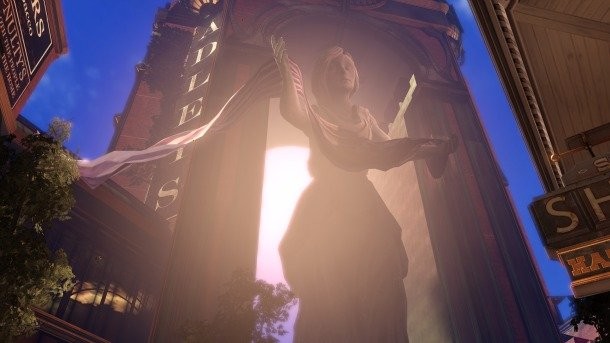
GI: How did you eventually tune into that turn of the century/fourth of July feel?
Wells: We were working on the game design and we had the city in the sky, and we had this sort of storyline that wasn’t really jelling yet. I would go to meetings and find myself trying to present ideas to people, and it wasn’t really happening, and it seemed that we just didn’t understand each other. I was watching this great PBS documentary called "America 1900," and it sort of talked about all the themes that were going on in America at the time. The two themes that we tuned into were the ones of – and we had already been talking about technology because it was such a stunning period of technology – but in a 20 year period you go from a backwater farming country to a country that has electricity, cars, airplanes, phonograph records, movies, and all these amazing things. Then you think about the 20 year period that we just went through, and all we have is one thing – the Internet. It is a big thing, but they had like 10 Internets in that period of time. The world was changing. I hadn’t really tuned into what was going on historically in America. It was sort of this watershed moment of America becoming what we think of America today. It was starting to express itself on the world stage and this incredible optimism came about in that period of time. About technology and America’s role in the world. America started becoming an empire in many ways.
Levine: The language was so brazen. Another book that I just finished is called Unfamiliar Fishes by Sarah Vowell. It is about the colonization and annexation of Hawaii. The speech is amazing. Henry Cabot Lodge and Teddy Roosevelt – they are just amazing. The brash sort of drive to imperialism and that it was god’s will to take Hawaii. That it was a moral and spiritual necessity to take it. Of course they were advancing all different types of political agendas, but they were tapping into all those expectations and the upsurge of exceptionalism.
Wells: They had a very genuine feeling that we had a role to play in the world. People called it the “white man’s burden” and it wasn’t cynical. They really were true believers. To take this American vision and spread it. From where they were sitting it was understandable. America really was a shining beacon. There weren’t a lot of democracies in the world. There were these dissolute monarchies that were about to be wiped off the face of the earth in WWI and replaced. The 20th century was a century of what political systems were going to replace monarchies, and that was the story of the 20th century. That story hadn’t been written yet. So I think Roosevelt and Cabot Lodge were hawks around the kindling were saying we have a role here and we need to bring democracy and Christianity to all these different people. These were complex individuals. Roosevelt was this incredible progressive and the guy who broke up the steal trusts. I’m drawn to people that I am simultaneously repulsed by and attracted to.
Levine: And it’s not the lowest hanging fruit, right? Everyone puts Hitler in their games in one way or another. That is the easy bad guy. There are more complex personalities to draw from in history than the world’s greatest and most evil dictators.
Wells: I have a very real affection for these complex characters. When we were working on BioShock – there is this great joke in Annie Hall where Diane Keaton says she's simultaneously attracted to and repulsed by the male member. I sort of feel that way about these characters. I’m both drawn to them and repelled by them, and that is where we need to be. Something that is both beautiful and horrifying at the same time. And that is how we make our games. I don’t want to write the mustached villain. We don’t want to make this world that is oppressive, dark, miserable, and evil. It is just not interesting.
GI: So once you settled in on the era and feel. How does the team go about creating that. Visual references?
Wells: For me a lot of it is mostly period independent. There is a sort of portability to familiar objects and familiar situations that people will always respond to, and it doesn’t matter what type of period you are trying to approximate. The key to me is getting this sense of human involvement and this feeling that humans have occupied these places that the gamer is now occupying, and doing that in a believable way and taking it very seriously. I find that a lot of games don’t go far enough in to making a world feel lived in. It takes about five times more stuff than most people put in. It really is a very involved process that includes a huge amount of layering and a huge amount of emotional involvement in that space. And that is only stage one. If I don’t establish some sort of narrative independence and make it a place that people feel is occupied, then Ken doesn’t have a place to tell his story. Because then it just becomes a story floating on top of some computer generated geography. It has to be more than that.
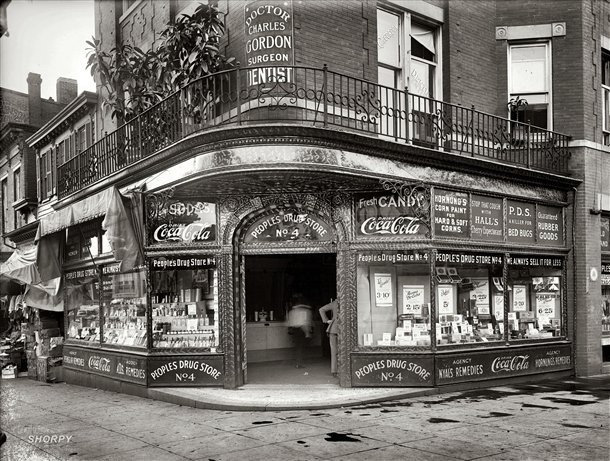
One of many photos used to inspire the game's design
GI: What resources do you draw from to recreate these?
Wells: We live in an East coast city, and we are in New York quite a bit too, so those are the best references for architecture. Architecture isn’t so much a concern. It is this very experiential thing where we will be walking through cities and finding elements that we want to bring into the game. So, obviously, having architectural accuracy, there are limitations. Really, it is about duplicating street-level experiences in the game, although research is important.
Levine: Once you buy into a period, obviously, you can’t put a building from the Jetsons in there because it will look really weird. But it isn’t about slavishly recreating every facet. It is about a feeling. And if that feeling matches the story beat we are going to tell, we go from there. But we spent more time talking about buildings.
Wells: The buildings are the brush, they aren’t the painting, and it’s easy to forget that sometimes. All those elements, no matter how sundry – okay, it’s just a fire escape – but all of those elements need to serve the story. As soon as you let go of that and just start to duplicate the world, you get a lot of orphaned objects that aren’t serving your story.
GI: What about accents, the way they speak, what they wear, and other cultural elements?
Wells: One of my big secrets about accents and the reason I tend to use them a lot is because when you are listening to a lot of people talking into your ear in a game, it could be confusing as to who is talking to you. So if we go to BioShock, we have Tenenbaum and Ryan, you know who is talking to you each time because their voices are so distinctive as opposed to playing a bunch of military games where you have a bunch of middle-aged white guys talking to you. When we are thinking about race and identity it is very important in Columbia. We spent a lot of time thinking about what is the nationality of this one particular character and she just changed actually. We thought about her story and where she would come from, and we wanted to put the most distance between her and other characters in the story.
Levine: Clothing is the same thing. Woe is the artist who doesn’t realize that games are an interactive medium, and that despite what period clothing is, there are some things that are going to read better in a video game and you need to embrace that. It may mean more saturated colors or blockier things rather than complex patterns. So much about the characters and their costumes is defined by the technology and what looks best on screen.
Wells: If you actually go down the street and look at cars and buildings and clothes, it is quite a mish mash, really. In our game to some degree, we are trying to identify more with a direct period so there is less divergence than there would be in real life.
GI: Again, what is the importance of making your setting a character?
Levine: The most data the player gets from the game – the most impulses – is from the world. And that is true of every game. If you don’’ leverage that world to tell your story, you are wasting about 80 percent of your data stream and communication tools for the player. It is as if you would write a novel and just use dashes over and over and over again because words aren’t important. In games we have worlds. Some people try to put their stories in cutscene. That isn’t how we do it.
Wells: The truth is that I work a long time on visuals long before there are events that are locked down, so I am not satisfied until I leave a space that is absent of gameplay and audio, but is already telling a story. I’m doing some polish work, and every object needs to be considered as to where it is helping or hurting the Columbia idea. You have to choose very wisely what you put in front of the player.


